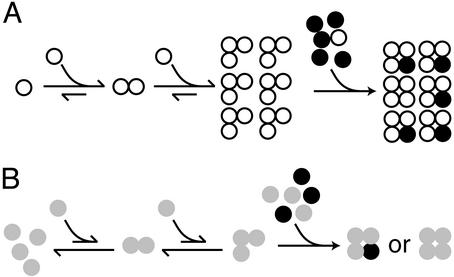Figure 5.
A model for the assembly of heteromeric CNG channels. (A) The monomers of wild-type A subunits (white circles) are quickly depleted to form trimeric assembly intermediates after they are synthesized. In the last step of the channel assembly, the B subunit (black circles) is dominant because its monomer concentration is much higher than the A monomers, and the 3A:1B heteromeric channels are preferentially produced. (B) The CLZ-disrupted mutant A subunits (gray circles) have a much smaller tendency to form the trimeric intermediate, and the monomer concentration remains high. The mutant A monomers can then compete with the B monomers to form a mixture of A homomeric and A/B heteromeric channels. Our data also suggest that a complex with more than one B subunit may be nonfunctional (see text). In any case, the likelihood of more than one B subunit in a wild-type complex is low because the wild-type A subunit already forms mostly trimers.

